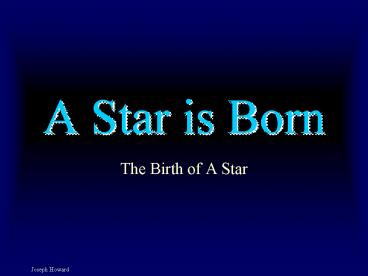A Star is Born - PowerPoint PPT Presentation
1 / 57
Title:
A Star is Born
Description:
Pow! Joseph Howard. Step Two. 1H 2H 3He g. Legend ... Boom! Joseph Howard. Step Three. 3He 3He 4He 1H 1H. Legend. Proton. Neutron. Positron (e ... – PowerPoint PPT presentation
Number of Views:54
Avg rating:3.0/5.0
Title: A Star is Born
1
A Star is Born
- The Birth of A Star
2
The Interstellar Medium
Two phases Gaseous 99 of
ISM 1. Largely Hydrogen (73) 2.
Helium (25) 3. Everything else on the
periodic table (lt2) Solid called dust
1 of ISM mostly heavier elements such as Fe,
silicates (sandy materials)
3
A Cloudy Situation
- Consider a large cloud (big!)
- Mass ? 100-1000M
- A temperature of ? 20K to 100K
- A density of about 10 atoms/cm3.
- So roughly speaking it is huge and cool.
4
Star Forming Regions
5
(No Transcript)
6
(No Transcript)
7
(No Transcript)
8
(No Transcript)
9
(No Transcript)
10
(No Transcript)
11
(No Transcript)
12
Cloudy Processes
Two processes are acting to change the clouds
shape.
- Thermal Energy (Kinetic) heat is trying to
disperse the cloud. - Gravity tries to force contraction.
13
Making A Star? Yet?
So theses two processes are acting in opposition
to each other. Which wins? Well, at least
sometimes gravity must win in order for stars to
ever form.
Stars are born from the collapse of a large cloud
with many smaller additional collapses or
fragmentations taking place during general
collapse.
14
In order for a cloud to collapse Its mass,
radius, and temperature must be suitable to allow
gravity to take over.
15
Star Forming Scenarios
Spontaneous Collapse The cloud just by
circumstance happens to finally find itself in
the proper environment to begin a gravitational
collapse. Forced Collapse A nearby event of
interaction with the could can push it over the
edge so that it can begin a collapse. How might
this occur?
16
Forced Star Formation
Cloud to Cloud Collisions Two clouds of various
size and temperature may actually collide with
each other causing the combination, one, or both
clouds to collapse gravitationally because during
the collision their respective density increases.
Supernovae Shock Waves The violent death of a
nearby star (or stars) can literally blast the
cloud into the correct conditions for a collapse.
Density Wave Within galaxies material (stars,
clouds, etc) seems to clump in areas where the
density of material is greater. These areas may
interact with clouds to cause collapses as well
17
Lets Make A Star
We start with a very large cloud of 100-1000M
100 K
The Cloud begins to collapse. Fragmentation
begins to occur. The smaller clouds continue to
collapse, and fragmentation occurs, over and over
again. Until we reach a more reasonable cloud
mass of about 1M
We will now continue along with one of these
relatively smaller cloud-lets.
18
Steps to a New Star
- Cloud begins to collapse. (Dé,Té) The density and
temperature begin to rise! (Strangely, during the
very first years (years to centuries) the clouds
temperature actually cools briefly before
beginning its rise upwards.) - Core of the cloud heats up to about 1000K ?
2000K. Cloud material begins to increase its
density further. (Dé).
19
(No Transcript)
20
(No Transcript)
21
(No Transcript)
22
Steps to a New Star
- Dust and outer regions of the cloud become
dense enough to absorb radiation and begins to
glow more in the infrared.
Remember about blackbody radiation - any heated
object will produce its own electromagnetic
radiation and it is only dependent on the
temperature of the object.
23
Steps to A New Star
- This protostar is a warm core with a
surrounding I.R. cocoon. It has a high luminosity
(because of its extremely large size several
103R), but it is still a relatively cool object.
As the protostar contracts, it emits clumps of
gas along its rotation axis.
These are called Herbig-Haro Objects.
24
Steps to a New Star
- Core continues heating up! (D é,T é)
- (Luminosity é, T é) The luminosity from the
warming core begins to drive off the outer
cocoon, exposing the hot core. As the protostar
begins to turn-on its brightness can vary and
its shape and surroundings can be filled with
leftover cloud material. - This type of object is called a T-Tauri Star.
25
(No Transcript)
26
(No Transcript)
27
(No Transcript)
28
Steps to a New Star
- Core continues to collapse and heat up until it
reaches about 10-15 million degrees Kelvin!! This
is very hot!! - When this temperature is reached in the inner
most portions of the protostar nuclear reactions
begin occurring and we now say that A Star is
Born!
29
A Star is Born!
- Pressure that is now being generated in the core
by these nuclear processes is enough to halt the
gravitational collapse of the star. The star is
surrounded by gas and dust and this may now be
the epoch where any remaining materials can
collect gravitationally into planets. Planet
Formation? - Star is on the Main Sequence.
30
(No Transcript)
31
(No Transcript)
32
(No Transcript)
33
How Long to Make a Star?
How long does this process require? (Contraction
to form a Main Sequence star?)
0.1M ? 1 billion years
1.0M ? 30 million years
2.0M ? 8 million years
15M ? 160,000 years
34
(No Transcript)
35
(No Transcript)
36
(No Transcript)
37
(No Transcript)
38
(No Transcript)
39
(No Transcript)
40
(No Transcript)
41
(No Transcript)
42
(No Transcript)
43
(No Transcript)
44
(No Transcript)
45
(No Transcript)
46
(No Transcript)
47
(No Transcript)
48
(No Transcript)
49
(No Transcript)
50
(No Transcript)
51
(No Transcript)
52
Proton Proton Chain
- Nuclear Fusion Stars
53
(No Transcript)
54
Step One
1H 1H ? 2H n e
55
Step Two
1H 2H ? 3He g
56
Step Three
3He 3He ? 4He 1H 1H
57
(No Transcript)































